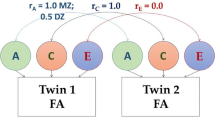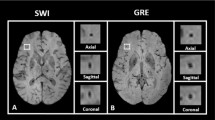Abstract
Incidental findings on structural cerebral magnetic resonance imaging (MRI) are common in healthy subjects, and the prevalence increases with age. There is a paucity of data regarding incidental cerebral findings in twins. We examined brain MRI data acquired from community-dwelling older twins to determine the prevalence and concordance of incidental cerebral findings, as well as the associated clinical implications. Participants (n = 400) were drawn from the Older Australian Twins Study. T1-weighted and T2-weighted fluid-attenuated inversion recovery (FLAIR) cerebral MRI scans were systematically reviewed by a trained, blinded clinician. Incidental findings were recorded according to pre-determined categories, and the diagnosis confirmed by an experienced neuroradiologist. Periventricular and deep white matter hyperintensities (WMH) were scored visually. WMH heritability was calculated for those with the twin pair included in the study (n = 320 individuals; monozygotic (MZ) = 92 twin pairs, dizygotic (DZ) = 68 twin pairs). Excluding infarcts and WMH, a total of 47 (11.75%) incidental abnormalities were detected. The most common findings were hyperostosis frontalis interna (8 participants; 2%), meningiomas, (6 participants; 1.5%), and intracranial lipomas (5 participants; 1.25%). Only 3% of participants were referred for follow-up. Four twin pairs, all monozygotic, had lesions concordant with their twin. Periventricular WMH was moderately heritable (0.61, CI 0.43–0.75, p = 7.21E-08) and deep WMH highly heritable (0.80, CI 0.66–0.88, p = 1.76E-13). As in the general population, incidental findings on cerebral MRI in older twins are common, although concordance rates are low. Such findings can alter the clinical outcome of participants, and should be anticipated by researchers when designing trials involving cerebral imaging.


Similar content being viewed by others
References
Al-Holou, W. N., Khan, A., Wilson, T. J., Stetler Jr., W. R., Shah, G. V., & Maher, C. O. (2011). Incidental findings on cranial imaging in nonagenarians. Neurosurgical Focus, 31(6), E11. doi:10.3171/2011.9.FOCUS11205.
Batouli, S. A., Sachdev, P. S., Wen, W., Wright, M. J., Ames, D., & Trollor, J. N. (2014). Heritability of brain volumes in older adults: The older Australian twins study. Neurobiology of Aging, 35(4), 937 e935–937 e918. doi:10.1016/j.neurobiolaging.2013.10.079.
Bedeschi, M. F., Bonaglia, M. C., Grasso, R., Pellegri, A., Garghentino, R. R., Battaglia, M. A., et al. (2006). Agenesis of the corpus callosum: Clinical and genetic study in 63 young patients. Pediatric Neurology, 34(3), 186–193. doi:10.1016/j.pediatrneurol.2005.08.008.
Bos, D., Poels, M. M., Adams, H. H., Akoudad, S., Cremers, L. G., Zonneveld, H. I., et al. (2016). Prevalence, clinical management, and natural course of incidental findings on brain MR images: The population-based Rotterdam scan study. Radiology, 281(2), 507–515. doi:10.1148/radiol.2016160218.
Boutet, C., Vassal, F., Celle, S., Schneider, F. C., Barthélémy, J.-C., Laurent, B., et al. (2017). Incidental findings on brain magnetic resonance imaging in the elderly: the PROOF study. Brain Imaging and Behavior, 11, 293–299. doi:10.1007/s11682-016-9519-4.
Carmelli, D., DeCarli, C., Swan, G. E., Jack, L. M., Reed, T., Wolf, P. A., et al. (1998). Evidence for genetic variance in white matter hyperintensity volume in normal elderly male twins. Stroke, 29(6), 1177–1181. doi:10.1161/01.str.29.6.1177.
Chen, X., Wen, W., Anstey, K. J., & Sachdev, P. S. (2009). Prevalence, incidence, and risk factors of lacunar infarcts in a community sample. Neurology, 73(4), 266–272. doi:10.1212/WNL.0b013e3181aa52ea.
Chitrit, Y., Coutant, C., Georges, P., Monthe, L., & Saint-Leger, S. (2009). Monochorionic diamniotic twins concordant for agenesis of the corpus callosum. Prenatal Diagnosis, 29(11), 1061–1063. doi:10.1002/pd.2336.
Colliot, S., Heim, M., Vincentelli, J. M., Jaquet, P., & Simonin, R. (1990). Familial primary empty sella turcica. Apropos of a family with 3 cases. Annales d'endocrinologie, 51(1), 39–42.
Fazekas, F., Chawluk, J. B., Alavi, A., Hurtig, H. I., & Zimmerman, R. A. (1987). MR signal abnormalities at 1.5 T in Alzheimer's dementia and normal aging. American Journal of Roentgenology, 149(2), 351–356. doi:10.2214/ajr.149.2.351.
Glass, H. C., Shaw, G. M., Ma, C., & Sherr, E. H. (2008). Agenesis of the corpus callosum in California 1983–2003: A population-based study. American Journal of Medical Genetics Part A, 146A(19), 2495–2500. doi:10.1002/ajmg.a.32418.
Gur, R. E., Kaltman, D., Melhem, E. R., Ruparel, K., Prabhakaran, K., Riley, M., et al. (2013). Incidental findings in youths volunteering for brain MRI research. Ajnr: American Journal of Neuroradiology, 34(10), 2021–2025. doi:10.3174/ajnr.A3525.
Håberg, A. K., Hammer, T. A., Kvistad, K. A., Rydland, J., Müller, T. B., Eikenes, L., et al. (2016). Incidental intracranial findings and their clinical impact; the HUNT MRI study in a general population of 1006 participants between 50-66 years. PloS One, 11(3), e0151080. doi:10.1371/journal.pone.0151080.
Illes, J., Kirschen, M. P., Karetsky, K., Kelly, M., Saha, A., Desmond, J. E., et al. (2004). Discovery and disclosure of incidental findings in neuroimaging research. Journal of Magnetic Resonance Imaging, 20(5), 743–747. doi:10.1002/jmri.20180.
Illes, J., Kirschen, M. P., Edwards, E., Bandettini, P., Cho, M. K., Ford, P. J., et al. (2008). Practical approaches to incidental findings in brain imaging research. Neurology, 70, 384–390.
Jansen, A. G., Mous, S. E., White, T., Posthuma, D., & Polderman, T. J. C. (2015). What twin studies tell us about the heritability of brain development, morphology, and function: A review. Neuropsychology Review, 25(1), 27–46. doi:10.1007/s11065-015-9278-9.
Kumar, R., Sachdev, P. S., Price, J. L., Rosenman, S., & Christensen, H. (2008). Incidental brain MRI abnormalities in 60- to 64-year-old community-dwelling individuals: Data from the Personality and Total Health Through Life study. Acta Neuropsychiatrica, 20, 87–90.
Leung, L. (2013). Incidental findings in neuroimaging: Ethical and medicolegal considerations. Journal of Neuroscience, 2013, 439145. doi:10.1155/2013/439145.
Liu, S., Buch, S., Chen, Y., Choi, H. S., Dai, Y., Habib, C., et al. (2016). Susceptibility-weighted imaging: Current status and future directions. NMR in Biomedicine. doi:10.1002/nbm.3552.
Longstreth, W. T., Manolio, T. A., Arnold, A., Burke, G. L., Bryan, N., Jungreis, C. A., et al. (1996). Clinical correlates of white matter findings on cranial magnetic resonance imaging of 3301 elderly people: The cardiovascular health study. Stroke, 27(8), 1274–1282. doi:10.1161/01.str.27.8.1274.
May, F. S., Chen, Q. C., Gilbertson, M. W., Shenton, M. E., & Pitman, R. K. (2004). Cavum septum pellucidum in monozygotic twins discordant for combat exposure: Relationship to posttraumatic stress disorder. Biological Psychiatry, 55(6), 656–658. doi:10.1016/j.biopsych.2003.09.018.
Morris, Z., Whiteley, W. N., Longstreth Jr., W. T., Weber, F., Lee, Y. C., Tsushima, Y., et al. (2009). Incidental findings on brain magnetic resonance imaging: Systematic review and meta-analysis. BMJ, 339, b3016. doi:10.1136/bmj.b3016.
Neale, M. C., Hunter, M. D., Pritikin, J. N., Zahery, M., Brick, T. R., Kirkpatrick, R. M., et al. (2016). OpenMx 2.0: Extended structural equation and statistical modeling. Psychometrika, 81(2), 535–549. doi:10.1007/s11336-014-9435-8.
R Core Team. (2015). A language and environment for statistical computing. Vienna: R Foundation for Statistical Computing.
Rijsdijk, F. V., & Sham, P. C. (2002). Analytic approaches to twin data using structural equation models. Briefings in Bioinformatics, 3(2), 119–133.
Rorden, C. (2015). MRIcron Version 1.
Sachdev, P., Lammel, A., Trollor, J., Lee, T., Wright, M., Ames, D., et al. (2009). A comprehensive neuropyschological study of elderly twins: The older Australian twins study. Twin Research and Human Genetics, 12(6), 573–582.
Sachdev, P., Thalamuthu, A., Mather, K., Ames, D., Wright, M., Wen, W., et al. (2016). White matter Hyperintensities are under strong genetic influence. Stroke, 47(6), 1422–1428. doi:10.1161/strokeaha.116.012532.
Sandeman, E. M., Hernandez, M. D. C. V., Morris, Z., Bastin, M. E., Murray, C., Gow, A. J., et al. (2013). Incidental findings on brain MR imaging in older community-dwelling subjects are common but serious medical consequences are rare: A cohort study. PloS One, 8(8), e71467. doi:10.1371/journal.pone.0071467.
Sarwar, M. (1989). The septum pellucidum: Normal and abnormal. Ajnr: American Journal of Neuroradiology, 10(5), 989–1005.
She, R., & Szakacs, J. (2004). Hyperostosis Frontalis Interna: Case report and review of literature. Annals of Clinical and Laboratory Science, 34(2), 206–208.
Traylor, M., Bevan, S., Baron, J.-C., Hassan, A., Lewis, C. M., & Markus, H. S. (2015). Genetic architecture of lacunar stroke. Stroke; a Journal of Cerebral Circulation, 46(9), 2407–2412. doi:10.1161/STROKEAHA.115.009485.
Vernooij, M. W., Ikram, M. A., Tanghe, H. L., Vincent, A. J. P. E., Hofman, A., Krestin, G. P., et al. (2007). Incidental findings on brain MRI in the general population. New England Journal of Medicine, 357(18), 1821–1828. doi:10.1056/NEJMoa070972.
Wen, W., & Sachdev, P. (2004). The topography of white matter hyperintensities on brain MRI in healthy 60- to 64-year-old individuals. NeuroImage, 22(1), 144–154. doi:10.1016/j.neuroimage.2003.12.027.
Wen, W., Thalamuthu, A., Mather, K., Zhu, W., Jiang, J., de Micheaux, P., et al. (2016). Distinct genetic influences on cortical and subcortical brain structures. Scientific Reports, 6, 32760. doi:10.1038/srep32760.
Yue, N. C., Longstreth Jr., W. T., Elster, A. D., Jungreis, C. A., O'Leary, D. H., & Poirier, V. C. (1997). Clinically serious abnormalities found incidentally at MR imaging of the brain: Data from the cardiovascular health study. Radiology, 202(1), 41–46. doi:10.1148/radiology.202.1.8988190.
Acknowledgements
Our sincere thanks to the twins who have donated their time to participate in the OATS, as well as the OATS Collaborative Research Team: New South Wales: Jocelyn Bowden, Suzy Forrester, Henry Brodaty, John Crawford, Tanya Duckworth, Kristan Kang, Amelia Assareh. Queensland: Natalie Garden, Nick Martin. Victoria: Christel Lemmon.
Author information
Authors and Affiliations
Corresponding author
Ethics declarations
Funding
The Older Australian Twins Study was supported by a National Health and Medical Research Council (NHMRC) / Australian Research Council (ARC) Strategic Award Grant of the Ageing Well, Ageing Productively Program (ID no. 401162). The Australian Twin Registry is supported by a Centre of Research Excellence Grant from the NHMRC administered by the University of Melbourne.
Conflict of interest
The authors declare that they have no conflicts of interest.
Ethical approval
The Older Australian Twins Study obtained approval from the ethics committees of the Australian Twin Registry, University of New South Wales, University of Melbourne, Queensland Institute of Medical Research, University of Queensland, and the South Eastern Sydney & Illawarra Area Health Service.
Human and animal rights
All procedures performed in studies involving human participants were in accordance with the ethical standards of the institutional and/or national research committee and with the 1964 Helsinki declaration and its later amendments or comparable ethical standards.
Informed consent
Informed consent was obtained from all individual participants included in the study.
Rights and permissions
About this article
Cite this article
Koncz, R., Mohan, A., Dawes, L. et al. Incidental findings on cerebral MRI in twins: the Older Australian Twins Study. Brain Imaging and Behavior 12, 860–869 (2018). https://doi.org/10.1007/s11682-017-9747-2
Published:
Issue Date:
DOI: https://doi.org/10.1007/s11682-017-9747-2




